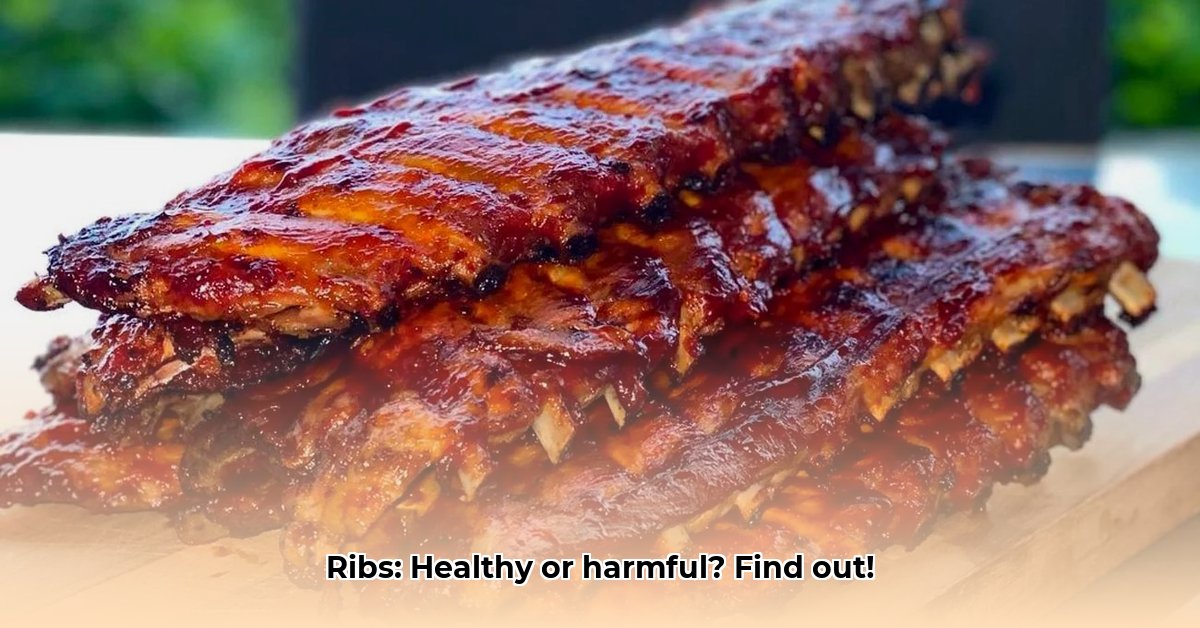Love ribs but worried about the health impact? You’re not alone! Ribs are undeniably delicious, but the high fat content can raise concerns about whether they’re a healthy choice. This comprehensive guide cuts through the confusion. We’ll explore the nutritional details of different types of ribs, show you how to cook them in healthier ways, and offer practical tips to enjoy ribs without sacrificing your health goals. We’ll even share insights from nutrition experts on incorporating ribs into a balanced diet. For more on healthy fats, check out this article on chicken skin health. Get ready to make informed choices and savor this tasty treat responsibly!
Decoding Ribs: Are They a Health Food or a Guilty Pleasure?
Let’s talk ribs. That mouthwatering aroma, those fall-off-the-bone tender morsels… who can resist? But are they really good for you? The truth, as with most foods, isn’t a simple yes or no. It’s more nuanced, a delicious balancing act between nutritional benefits and potential drawbacks. What essential nutrients do ribs provide, and what are the potential health drawbacks we need to consider? Let’s dive in.
The Nutritional Lineup: Good, Bad, and the In-Between in Ribs
Ribs, especially pork ribs, offer some nutritional wins. They’re a decent source of protein, which is vital for building and repairing your body’s tissues. Think strong muscles and healthy cell function. Plus, they pack a few essential vitamins and minerals – iron, zinc, selenium, and B12 are in there. These nutrients contribute to energy levels, a robust immune system, and overall well-being. A 3-ounce serving of pork ribs contains approximately 21 grams of protein, providing all nine essential amino acids our bodies cannot produce on their own. So, ribs contribute some good things but also present areas for mindful consideration.
Facing the Fat: The Dominant Factor in Ribs
The biggest nutritional challenge with ribs is their fat content. They’re known for being rich in fat, and a significant portion of that is saturated fat. While fats are essential for health, aiding in the absorption of certain vitamins and minerals, saturated fat is linked to increased cholesterol levels and potential heart problems when consumed in excess. Think of it as needing a small amount of fuel to power a car, too much will flood the engine. The amount of fat varies depending on the cut you choose. Spare ribs generally have a higher fat content than baby back ribs. A 3-ounce serving of pork ribs contains around 19 grams of fat, with 7 grams of saturated fats. However, pork ribs also contain oleic acid, a type of monounsaturated fat also found in olive oil, known for its positive effect on lowering cholesterol levels and reducing inflammation in the body. It’s important to consider the balance of different types of fats in your diet.
Hidden Calories: Sugar and Salt in Ribs Recipes
Many commercially prepared ribs – and even some homemade ones – are loaded with extra sodium (salt) and sugar. These additions aren’t doing you any favors. They dramatically boost the calorie count, potentially affecting your blood pressure and blood sugar. A single 3-ounce serving of pork ribs contains around 330 milligrams of sodium, which represents almost 15% of the recommended daily intake according to the American Heart Association. Excessive sodium consumption has been linked with increased blood pressure levels, which can lead to serious health issues over time including stroke and heart attack. Many types of ribs are pre-seasoned or come in a sauce that contains additional ingredients beyond just the meat itself, including high fructose corn syrup, MSG, and other artificial flavorings and colorings. These types of chemical compounds have been linked with negative health outcomes ranging from obesity and diabetes to neurological issues and cancer. Paying attention to ingredient labels and making informed choices is crucial for managing these hidden elements.
Cooking Counts: Smart Methods for Preparing Ribs
How you cook your ribs makes a big difference in their overall health profile. Grilling, baking, or slow cooking are healthier options than deep frying. Frying soaks the ribs in extra fat and calories – not a plus. Braised or grilled pork ribs may be a healthier alternative due to the fact that they don’t involve submerging the meat in unhealthy oils. Also, care should still be taken to avoid overcooking the meat or using overly sugary marinades or sauces that contain added sugars or high fructose corn syrup. Using healthier cooking methods can significantly mitigate the potential risks associated with eating ribs.
Sauce Savvy: Building Flavor Without the Excess
Let’s talk about sauces and marinades; many are full of extra sugar and salt, negating many of the nutritional benefits . It’s best to use lighter homemade sauces, or at least check the nutrition labels carefully. The carbohydrate count can climb steeply when a generous amount of sauce is slathered on the ribs. Consider reducing the amount of sauce used, choosing a low-sugar option, or making your BBQ sauce where you can control the amount of sugar added.
Portion Power: Eating Right When Consuming Ribs
Portion control is essential. Even the healthiest foods, when eaten in huge amounts, can lead to weight gain. Think of ribs as a special occasion treat, not an everyday meal. A typical serving size for pork ribs is around 3-4 ounces. It’s recommended to limit your consumption of pork ribs to once or twice a month. Balance, my friends, is the key to a healthy and enjoyable diet.
Who Should Be Extra Careful About Eating Ribs?
People with health conditions like high cholesterol, high blood pressure, diabetes, obesity, or heart disease should be extra cautious about eating ribs. In just a single 3-ounce serving of pork ribs, there are approximately 5 grams of saturated fat and around 75 milligrams of cholesterol. For those who consume a lot of meat or have other dietary factors contributing to their overall saturated fat and cholesterol intake, it may be wise to limit their consumption of pork ribs or choose leaner alternative cuts of meat instead. Anyone watching their sodium intake needs to pay close attention to those store-bought sauces and marinades. If you have concerns, it’s always a good idea to talk to a doctor or registered dietitian. They can help you figure out how many ribs fit into a balanced diet just for you.
A Step-by-Step Guide to Healthier Ribbing
Here’s how to make this delicious food just a little bit healthier:
- Choose Your Cut Wisely: Go for leaner cuts like baby back ribs. They have less fat overall.
- Trim the Fat: Before cooking, trim away any visible fat. Less fat means fewer calories.
- Smart Cooking Method: Grill or bake those ribs instead of frying.
- Sauce Strategically: Opt for homemade, low-sodium, low-sugar marinades and sauces.
- Portion Control: Keep those servings reasonable. Enjoy ribs as a special treat, not a regular meal.
The Verdict: Are Ribs Healthy for You?
So, the big question: are ribs healthy? It’s not a simple yes or no. Ribs, enjoyed in moderation and prepared with care, can fit into a healthy eating plan. But, their high fat and calorie content mean careful attention is essential. Registered dietitian Alissa Rumsey says, “Pork ribs can certainly fit into a healthy diet if prepared properly.” Lean cuts, smart cooking, and portion control are your allies for truly guilt-free enjoyment. Think of it as a delicious treat, not a dietary staple. Registered dietitian, Christy Brissette says, “Pork ribs can be part of a healthy diet when eaten in moderation and as part of a well-balanced meal.” And remember – balance is everything! There is ongoing research into the effects of different types of fats, so our understanding of the health impacts of ribs might evolve over time. Given the evolving understanding of fats, it’s wise to periodically reassess dietary guidelines surrounding rib consumption based on the latest scientific evidence.
How to Choose the Healthiest Pork Ribs and Prepare Them for Mindful Eating
Key Takeaways:
- Pork ribs offer protein, iron, and B vitamins, but are high in fat, saturated fat, cholesterol, and sodium.
- Choosing lean cuts (baby back ribs), trimming excess fat, and controlling portions are crucial.
- Baking or grilling is healthier than frying.
- Limiting rib consumption to 1-2 times a month aligns with a balanced diet.
Understanding the Pork Rib Nutritional Landscape
Let’s face it: ribs are delicious. But are they healthy? The answer isn’t a simple yes or no. Pork ribs provide protein and essential micronutrients like iron, zinc, phosphorus, selenium and vitamin B12. However, they’re also rich in fat, particularly saturated fat, which can impact heart health. Sodium content is another concern, especially in processed varieties.
The nutritional profile varies considerably depending on the cut of ribs. Baby back ribs generally have less fat than spare ribs. This is a key factor when choosing the healthiest pork ribs.
Navigating the Rib Cuts: A Buyer’s Guide
Different cuts mean different nutritional profiles. Baby back ribs are often considered the leanest option. Spare ribs, on the other hand, tend to be richer in fat. Understanding these differences is key to making informed choices. Before you buy, consider:
- Type: Baby back? Spare? St. Louis-style? Each varies in fat and caloric content.
- Appearance: Look for ribs with a good amount of marbling (intramuscular fat that contributes to flavor and tenderness), but avoid those with excessive fat.
- Processing: Choose minimally processed ribs to avoid added sodium, sugars, and preservatives.
Cooking Methods: From Frying Pan to Grill
How you prepare your ribs significantly impacts their healthfulness. Frying adds extra fat and can create harmful compounds called heterocyclic amines (HCAs) and polycyclic aromatic hydrocarbons (PAHs). Grilling, baking, slow cooking and steaming are much healthier alternatives.
Here’s a quick comparison:
| Cooking Method | Fat Added | Carcinogens | Health Impact |
|---|---|---|---|
| Frying | High | High | Least Healthy |
| Grilling | Low to Moderate | Moderate | Moderately Healthy |
| Baking | Low | Low | Most Healthy |
| Slow Cooking | Minimal | Low | Healthy |
| Steaming | None | N/A | Healthiest |
For how to choose the healthiest pork ribs and prepare them for mindful eating, prioritize baking, grilling, slow cooking or steaming, and use low-sodium marinades or rubs. Opt for healthier cooking methods to reduce excess fat. Consider grilling to drain fat away from the ribs, baking to control the temperature and create a more uniform cook, slow cooking to ensure tenderness without adding unhealthy fats, and steaming to keep ribs moist and succulent without excess fat.
Mindful Eating: Portion Control and Frequency
Even the leanest, most healthily prepared ribs should be enjoyed in moderation. A 3-4 ounce serving is a reasonable portion. Keep your overall dietary intake in mind. Integrating ribs into a balanced diet featuring diverse proteins and plenty of fruits, vegetables, and whole grains is essential. Aim for only 1-2 servings per month, at most.
Beyond the Ribs: Exploring Healthier Alternatives
While enjoyable occasionally, remember that pork ribs shouldn’t be a dietary staple. Chicken breast, salmon, and tofu offer excellent sources of protein with fewer negative health consequences. Diversify your protein sources for better overall health.
Choosing Lean Pork Rib Cuts for Healthier Grilling
Key Takeaways:
- Pork ribs offer protein and essential nutrients, but their high fat, saturated fat, and sodium content require mindful consumption.
- Choosing lean pork rib cuts, like baby back ribs, and employing healthy cooking methods significantly impacts overall healthfulness.
- Portion control is crucial, regardless of the cut or cooking method.
- Added sugars and sodium in sauces and marinades substantially alter the nutritional profile.
Understanding the Rib Landscape: Baby Backs vs. Spare Ribs
Let’s face it: ribs are delicious. But are they healthy? That depends. The key lies in understanding the differences between cuts and how you prepare them. Baby back ribs generally boast a leaner profile compared to spare ribs, which tend to be fattier. Think of it like this: baby backs are the marathon runners; spare ribs, the sprinters—delicious, but potentially more calorically dense.
Navigating the Nutritional Maze of Pork Ribs
Pork ribs, regardless of the cut, are a good source of protein and certain micronutrients like iron and B vitamins. However, their fat content – particularly saturated fat – and often high sodium levels present potential health concerns if consumed frequently or in large portions. These can contribute to cardiovascular issues and other health problems. Remember, moderation is key.
Grilling Smarter, Not Harder: Minimizing Risks While Grilling Ribs
Grilling itself introduces some complexities. While grilling offers tasty flavor, high heat can potentially form compounds of concern, such as heterocyclic amines (HCAs) and polycyclic aromatic hydrocarbons (PAHs). However, choosing lean pork rib cuts and trimming visible fat before grilling minimizes the negative impacts.
Sauces and Marinades: Hidden Calories and Sodium in Ribs
Many rib recipes rely heavily on sauces and marinades. These often pack a punch of added sugars, sodium, and unhealthy fats. Opt for low-sodium options or make your own using herbs, spices, and a touch of healthy oil. Consider using mustard as a base for a homemade dry rub to provide a satisfying balance of heat and tang, further decreasing the need for heavy sauces or dressings.
Portion Control: Your Secret Weapon for Enjoying Ribs
No matter how lean the cut or how healthy the preparation, portion size plays a significant role. A small serving of ribs as part of a balanced meal is far different than a large portion consumed regularly.
Making Informed Choices: A Practical Guide to Eating Ribs
- Choose wisely: Opt for baby back ribs over spare ribs for leaner grilling.
- Trim the fat: Remove as much visible fat as possible before cooking.
- Grill with care: Use moderate heat and avoid burning the ribs.
- Sauce sparingly: Choose low-sodium marinades or make your own.
- Control portions: Enjoy ribs as an occasional treat, not a staple.
The Bottom Line: Enjoy Ribs Responsibly
Ribs can be part of a healthy eating pattern, but mindful choices are crucial. By choosing lean pork rib cuts and preparing them thoughtfully, you can appreciate their flavor without compromising your well-being. Opting for leaner cuts, applying tasty marinades and seasonings early in the cooking process, and knowing how to effectively employ different cooking methods will allow us to savor delicious pork ribs without fretting over calorie consumption.
Nutritional Comparison of Spare Ribs vs. Baby Back Ribs Cooking Methods
Key Takeaways:
- Spare ribs and baby back ribs differ significantly in their location on the pig, resulting in variations in size, fat content, and cooking time.
- Baby back ribs are smaller, leaner, and generally more expensive than spare ribs.
- Spare ribs, originating from the belly, are larger, flatter, and contain more fat and bone. They require longer cooking times.
- The “best” rib type is subjective and depends on individual preferences. Cooking method also significantly impacts the final product.
- Understanding these differences helps you make informed choices for purchasing and preparing ribs.
Anatomy of a Rib: Spare vs. Baby Back Ribs
Let’s dive into the differences between spare ribs and baby back ribs. It all starts with where they come from on the pig. Spare ribs hail from the lower rib cage, near the belly. They’re larger, flatter, and have more fat and bone. Baby back ribs, on the other hand, come from the upper rib cage, closer to the loin. This location gives them a smaller, curvier shape with less fat, hence they’re often leaner. Think of it like this: spare ribs are the hearty, full-bodied siblings, while baby back ribs are the more refined, slender cousins.
Nutritional Comparison of Spare Ribs vs. Baby Back Ribs Cooking Methods: A Closer Look
Nutritional content varies based on the cut and cooking method, but some general differences exist. Spare ribs typically have a higher fat content due to their location, potentially leading to more calories. However, that fat also contributes to flavor and juiciness. Baby back ribs, being leaner, often have fewer calories and less fat. But leaner doesn’t always mean healthier; it can also mean drier and less flavorful if not cooked correctly.
The cooking method significantly affects the nutritional profile. Slow cooking, like smoking or braising, may render some fat, altering the final caloric and fat content. Grilling or broiling, particularly at high temperatures, may leave more fat intact. Ultimately, we aren’t just comparing spare vs. baby backs but also the impact of different cooking techniques on their nutritional composition.
| Rib Type | Fat Content (Approximate) | Calories (Approximate per serving) | Cooking Time (Approximate) |
|---|---|---|---|
| Spare Ribs | Higher | Higher | Longer |
| Baby Back Ribs | Lower | Lower | Shorter |
Note: These are approximate values and can vary significantly based on the specific cut, cooking method used, and portion size.
Cooking Methods and Their Impact on Ribs
How you cook your ribs significantly impacts their final nutritional profile. Slow cooking methods, such as smoking or braising, allow for fat to render, potentially reducing the overall fat content during preparation. However, they often increase cooking time. Faster methods, like grilling or broiling, retain more fat, which can influence the calories and fat levels in your finished dish. Therefore, the Nutritional Comparison of Spare Ribs vs. Baby Back Ribs Cooking Methods isn’t just about the type of rib, but also how you prepare it.
Making Smart Choices About Ribs
So, are ribs healthy? The answer, as with most foods, is nuanced. Ribs, whether spare or baby back, are a source of protein and certain B vitamins. But they’re also relatively high in saturated fat and sodium, particularly when prepared with added sauces or seasonings. Moderation is key. Enjoy ribs as part of a balanced diet, not as a regular staple. Choose leaner cuts (baby back) if you’re watching your calorie and fat intake. Experiment with different cooking methods and flavor profiles to find what best suits your taste preferences and dietary needs. Consider portion control; a smaller serving of ribs can help maintain a balanced nutritional intake.
- Mini Bento Boxes For Packing Kids Snacks And Small Meals - December 27, 2025
- Small Bento Box Makes Packing Lunch Easy and Fun Again - December 26, 2025
- Adult Bento Box Lunch Ideas For Quick Healthy Portable Options - December 25, 2025










